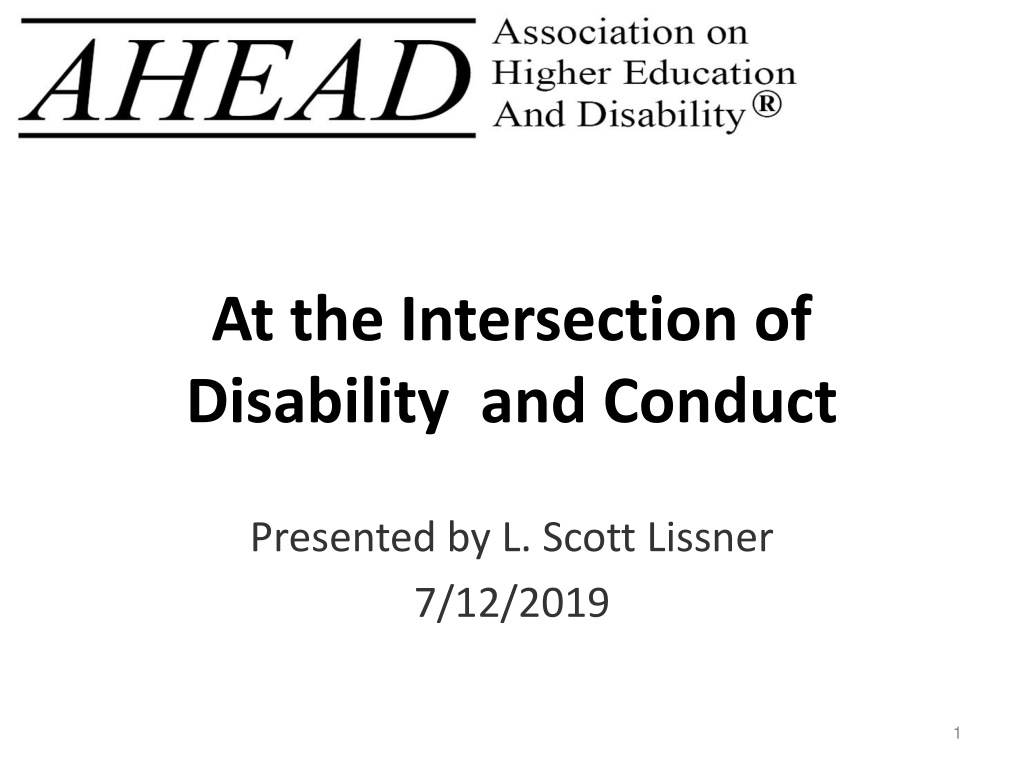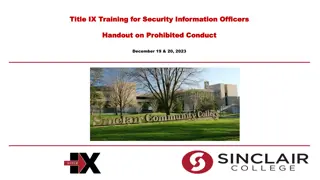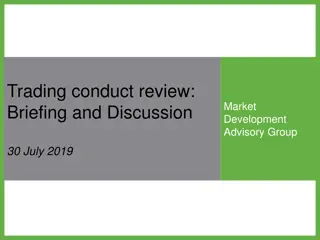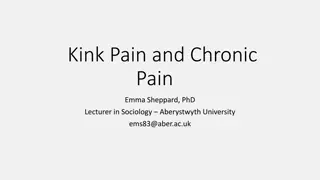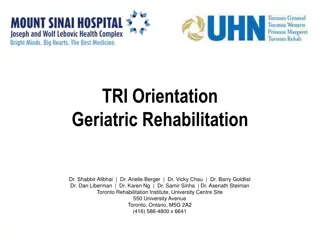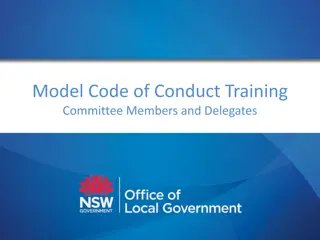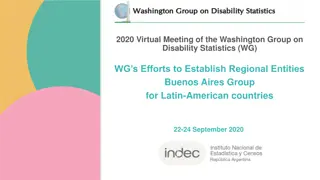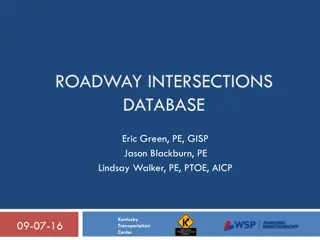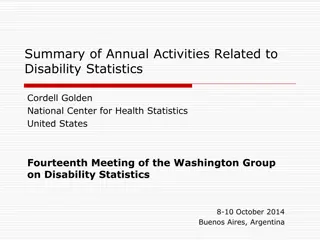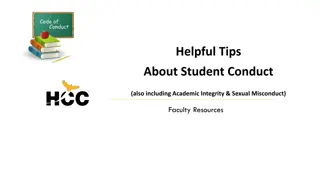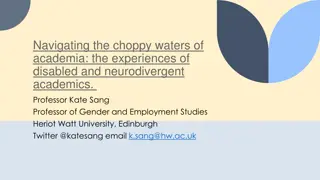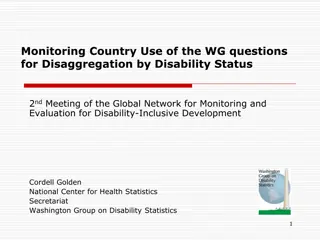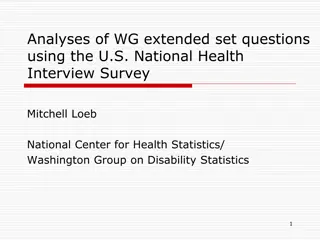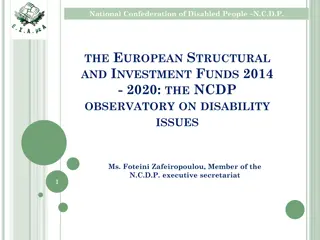Navigating Intersection of Disability & Conduct in Academic Settings
The presentation delves into the complexities at the intersection of disability and conduct in academic environments. It highlights the need to differentiate between processes, standards, and actual misconduct that violate codes of conduct. Emphasis is placed on ensuring fair treatment, due process, and accommodations for students with disabilities facing conduct-related challenges.
Download Presentation

Please find below an Image/Link to download the presentation.
The content on the website is provided AS IS for your information and personal use only. It may not be sold, licensed, or shared on other websites without obtaining consent from the author. Download presentation by click this link. If you encounter any issues during the download, it is possible that the publisher has removed the file from their server.
E N D
Presentation Transcript
AHEAD At the Intersection of Disability and Conduct Presented by L. Scott Lissner 7/12/2019 1
What is the Issue? Things to distinguish Process and Substance Academic and technical standards from conduct Actual misconduct that violates the code of conduct Violent Disruptive Illegal Contrary to mission Threat of future misconduct Disturbing behavior, language or writing that is a raises a reasonable apprehension of a future misconduct
Intersection with Disability Is there an assumption of disability? Are the standards the same as those applied to similarly situated non-disabled students? Is the student receiving the same level of due process? Is the student able to argue that disability is an extenuating circumstance to the same degree that other forms of extenuating circumstances are considered?
Academic/Technical Standards & Due Process Was there effective notice of the accommodation process? Was the student authorized to receive an accommodation? Was the accommodation implimented? If not: Was there a logical nexus between the disability, the failed accommodation and the performance issue? Were institutional actors responsible for the failure?
Conduct-Based Dismissal Is this a violation of an essential element of the code of conduct, or a direct threat to the health and safety of others or a threat to self (direct or otherwise)? About an current behavior About a potential behavior
Conduct Dismissal and Disability Violation of code of conduct by a student with a disability If the violation is clearly related to a student s disability then consequences/penalty may be accommodated if Violation was not essential (harm/disruption not substantial, code provides discretion in penalty, history of findings ) Accommodations are likely to prevent a repetition of the behavior or a fulfillment of the threat
If in the and essential Is the student being held to any higher standard than nondisabled students? Is the discipline or degree of discipline any harsher than that applied to nondisabled students? Does this process the college applies to students generally consider extenuating circumstances for similarly situated students? Violation phase? Penalty phase? If so, then allow the student to argue his/her disability as an extenuating circumstance with regard to violation or penalty
Direct Threat Analysis Bring the student in for a meeting, explain what was observed. State why you are concerned. Ask the student for an explanation. If a reasonable apprehension remains that the student represents a direct to the safety of others: Consult with treating physician, if not satisfied Ask the student to consent to an independent medical examine at the college s expense
Threat Analysis For the independent medical exam (IME): Ensure that the examiner is asked to conduct an inquiry consistent with the correct direct threat standards (School District of Nassau Cty. v. Arline). Based on reasonable medical judgments, given the state of medical knowledge Nature of risk Duration Severity of risk Probability of transmission and harm of transmission
Direct Threat to Others Remember that if the examiner concludes that the student represents a direct threat, the examiner must also reach a conclusion whether with accommodation, the degree of threat would be reduced to an acceptable, safe, level. If the student won t consent, advise the student that you will make a direct threat determination based what you have observed.
Direct Threat to Others Based on information from the student, the student s physician, the individual s (teachers and students) who have been observing the student s behavior, the IME you can conclude either that The student represents a direct threat to the health and safety of others, but can, with reasonable accommodation can reduce the threat; or The student represents a direct threat and no reasonable accommodation exists that will reduce the threat:
Threat to Self A student who: Is academically qualified Has not violated the code of conduct, for example with regard to: Drinking Disruption Destruction of property Is not a direct threat to others
Readmission When does a method of administering requests for readmission by students with disabilities reflect individualization vs. impermissible generalizations?
Establish a written procedure, reviewed by OCR, for students requests for readmission following a medical withdrawal: Apply to all medical withdrawals, including for physical and psychological reasons An individualized determination as to what documentation would be required Training on it to all staff involved in processing requests for readmission after a medical withdrawal Publicize the procedure so that students considering a leave would know in advance what was expected when they would return.
Not on the Radar: Sexual Assault of College Students with Disabilities https://ncd.gov/publications/2018/not-radar- sexual-assault-college-students-disabilities
DOJ Settlement with Northern Michigan University (treatment of students with mental health challenges) MBAWE v. Ferris State Univ., 6th Cir. (unpublished) pharmacy student with a psych disability who refused accommodation of monitoring was not otherwise qualified individual UCLA v. Superior Court remand (tort liability not limited to a special standard of requiring a higher level of foreseeability) 16
CONTACT L. Scott Lissner, ADA Coordinator & 504 Compliance Officer The Ohio State University 21 East 11th Ave. Columbus, OH 43210 Lissner.2@OSU.EDU Http://ada.osu.edu (614) 292-6207(v); (614) 688-8605(tty) (614) 688-3665(fax) 17
BONUS SLIDES 18
Who is a Qualified Individual? To determine if a person is a qualified individual, ask two questions: Does the person meet the necessary pre-requisites for the course, program, job? Can the person engage in the essential tasks or activities, with reasonable accommodations if needed? 19
When Are Accommodations Reasonable? Addresses an impact of the disability Manner, Condition & Duration not outcome Does not create a fundamental alteration Comparable experience, performance or evaluation Does not create a Direct Threat to others Likely, imminent, significant & can not be substantially reduced with accommodations Does not create an undue burden Administrative, Financial, 20
Characteristics of Lawful Technical Standards It pertains to the essential (core) rather than the tangential aspects of the program It is an inquiry into a skill or ability rather than a medical condition. The ability to perform the skill directly relates to academic or programmatic success It pertains to the safe performance of the skills the program seeks to develop In a licensing program, it is directly related to skills necessary to obtain the license
Direct Threat A direct threat means a significant risk of substantial harm to the health and safety of others (or self in employment) that cannot be eliminated or reduced by reasonable accommodation--A significant risk is a high, and not just a slightly increased, risk.
Direct Threat (continued) Individualized Analysis Reasonable medical judgment relying on current medical knowledge and/or the best available objective evidence (Echazabal v. Chevron) Deference to the treating physician
Safety Considerations The nature, severity and duration of the potential harm; The likelihood that the potential harm will occur; The imminence of the potential harm; and The potential for reasonable accommodations to mitigate the risk.
NACUA 1/2018 Principles for Students Who Pose a Risk of Self-Harm National Association of College & University Attorneys January 26, 2018 On January 26, 2018, Candice Jackson, Acting Assistant Secretary for the U.S. Department of Education Office for Civil Rights, participated in a NACUA Briefing and described principles to guide colleges and universities in their efforts to address students who pose a risk of self-harm. Assistant Secretary Jackson said the principles are gleaned from past resolution agreements and that OCR is and will continue to be guided by these principles in its enforcement approach in matters involving students at risk of self-harm. Assistant Secretary Jackson began by stating that OCR appreciates the good faith and dedication that institutions have been demonstrating in addressing the risk of student self- harm for many years, particularly given some lack of clarity in the past few years. OCR believes that most institutions are on the right track in handling these matters. She then offered the following general principles: 25
NACUA 1/2018 1. Colleges and universities always have the option of offering mental health services to students, whether or not the students are identified as having a mental health issue and whether or not the students are in crisis. 2. Institutions should consider reasonable accommodations that would enable the student to remain enrolled and/or on campus. The college environment should be safe, inclusive, and nondiscriminatory. Where possible, and consistent with the Americans with Disabilities Act, institutions should explore whether a student at risk of self-harm may remain enrolled at the institution, with or without reasonable accommodations. Institutional policies that refer instances of self-harm to the student discipline system, and offer no other channels for accommodation, may be found by OCR to have a discriminatory effect. 3. Where separation from the institution is considered, institutions should encourage and prioritize voluntary actions by the student where feasible. 26
NACUA 1/2018 4. OCR looks for institutional policies that are non-discriminatory on their face and that treat similarly-situated disabled and non-disabled students similarly. A policy that singles out particular mental diagnoses would be problematic. A policy that treats mental health differently from other medical conditions would be problematic. 5. Involuntary separations from enrolled status may be utilized as a last resort. Students must be afforded a fair process to contest an involuntary separation. Involuntary leave policies should be based on the student s particular circumstances rather than a one-size-fits-all or minimum mandatory durations for certain types of leaves; however, this principle does not prevent the application of general academic policies to all students who take leaves of absence. 6. When responding to a student self-harm situation, colleges and universities should conduct an individualized assessment of the risk of self-harm by the particular student. Actions should not be tied to myths, fears, or stereotypes about mental illness. Actions should develop from a premise of doing what s right and appropriate for a particular student. A one-size-fits-all approach is a potential red flag; instead, institutions should tailor their assessments and actions to individual circumstances. 27
NACUA 1/2018 7. OCR expects institutions to respond to student s risk of self-harm in a reasonable and fair manner. A fair process typically should include: 1. Notice; 2. Information about the process; 3. An opportunity to provide information that the student wants to have considered; and 4. The institution s careful consideration of the information provided by the student, with due weight given to the student s health care providers. A fair process calls upon institutions to consider the context in which the information is exchanged, including the seriousness of the crisis the student may be facing. Institutions may still take swift action or call on law enforcement in exigent circumstances to detain the student, but the use of law enforcement should not be the only option considered. As with other aspects of the assessment, institutional actions in non-emergency situations should be undertaken only when based on individualized assessments. 28
NACUA 1/2018 8. As part of an individualized assessment, institutions may consider medical and clinical information. Input from qualified health providers is relevant to individualized assessments. A student s treatment provider should be given an opportunity to provide information and their input given serious consideration. Institutional requests for medical information should not be overly broad and should be tailored to whatever information is necessary for qualified personnel to assess the risk of self-harm. Medical and clinical information provided to the institution should be reviewed and interpreted by qualified personnel. Any actions taken in reliance on medical/clinical information should be reasonably linked to the information gleaned from the medical/clinical information. As part of its individualized assessment, an institution may consider the impact of the student s behavior on others in the community. 29
NACUA 1/2018 9. Institutions may impose reasonable, individualized conditions for students returning after a leave of absence. Conditions must be individually tailored to a student s unique circumstances. In setting conditions for return, while institutions may consider a uniform set of criteria in all cases (which should be set forth in applicable policy), each individual case must be considered on its merits and facts. Imposition of one-size-fits-all conditions for return from leaves of absence would not be consistent with OCR s expectation that institutions will always undertake a thoughtful and fair individualized assessment of a student s unique circumstances. Institutions can require medical evaluations from treatment providers in preparing for a student s return and can require compliance with a medically prescribed treatment plan. Institutions may execute individually-tailored behavioral contracts with students upon their return and hold students accountable to the terms of the contract. Finally, Assistant Secretary Jackson said it would be prudent for colleges and universities to avoid use of the direct threat to self terminology and framework, and suggested institutions should focus on generally applicable health and safety requirements and conduct individualized assessment of a student s risk of self-harm under the principles outlined above. 30
